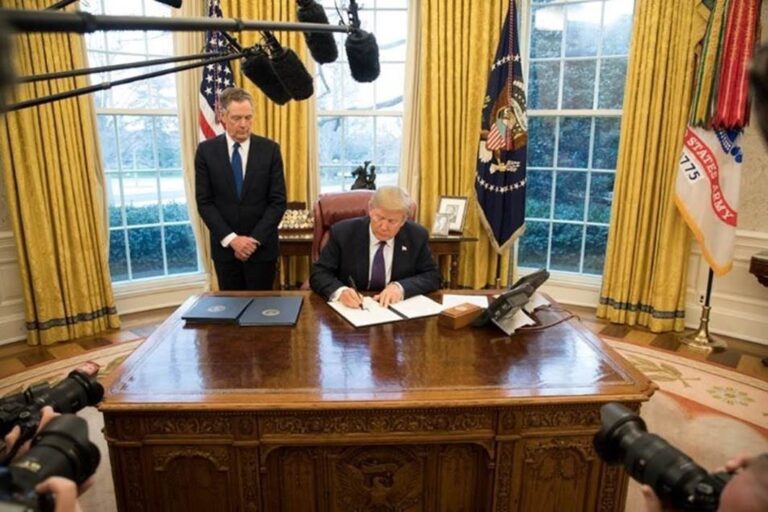From 5 April, the Trump administration has adopted the rates that apply to most countries with a rate of 10%. The rates apply to a wide range of imports, which cover most products.
The rates are replaced by a higher “reciprocal” rate between 11% and 50% to 60 countries from 9 April and are designed to match rates and related commercial enforcement from 60 countries.
The extra rates do not apply to “energy and energy products”, as well as steel and aluminum, which recently applied 25% rates in February.
“Large and continuing annual US trade shortages have led to the roll-out of our production base; inhibited our ability to scale up advanced domestic production capacity; undermined critical supply chains; and made our defense industrial basis dependent on foreign opponents,” said the executive order.
The executive order Signed by President Trump that adds 25% rates for imported steel and aluminum of most global providers will increase the costs for all project types, from small residential solar projects to the largest solar panels on utility scale.
Sinolink Securities said that aluminum frames were the most expensive production component of solar panel in November 2024, Represents 14% of the total production of solar panel Costs.
In December, the Biden administration Doubled rates for solar products from China. Section 301 rates are 50% for polysilicon, waffles and solar cells for products imported from China.
The market for the American solar module saw one 4% increase in DecemberWith $ 0.01 per watt up to $ 0.26 per watt. Modules with cells from Cambodia, Malaysia, Thailand and Vietnam – countries affected by the policy – saw a price increase of 7.7% from November to December. Although those prices have since been somewhat illuminated, they remain raised, said an Anza report.
The new round of April 5 does not apply to goods sent from Canada and Mexico that are already being assessed with 25% rates.
“The new rates will not apply to certain articles that Trump has already chosen for current or possible future sector-specific rates, such as steel, aluminum, some electric products that steel or aluminum, pharmaceuticals, cars and car parts, semi-lovers, semiconductucten, semiconduct construct semiconductoren, semiconductoren, semiconductoren, semiconductoren, semiconductoren, semiconductoren, semiconductoren, semiconductoren, semiconductoren, bepaalde kritische mineralen en energie- en energieproducten gebruiken, zoals staal en energie-en energie-producten gebruiken, zoals staal en energie en energie-producten gebruiken,” zei Keith Martin, Partner, Norton Rose Fulbright.
An appendix to the Trump order gives an overview of industry-specific materials that are not affected with the new rates. Polysilicon and other relevant materials are exempt from the increased rates. Find the Full enclosed list here.
The import from countries that will be assessed on April 9 higher rates include:
| China | 34% |
| Eu | 20% |
| Vietnam | 46% |
| India | 26% |
| South Korea | 25% |
| Indonesia | 32% |
| Malaysia | 24% |
| Cambodia | 49% |
| Israel | 17% |
| Japan | 24% |
| Taiwan | 32% |
The new rates are a supplement to some existing rates, said Martin. “At the beginning of April 9, for example, Chinese goods will be subject to rates of 54%: an existing rate of 20%that Trump previously imposed plus a new mutual percentage of 34%.”
AD/CVD rates
“If we want a flourishing solar industry of solar energy-one that supports well-paid American jobs, delivers and provides energy independence On PV Magazine USA.
The solar industry also responds to rates created by a new round of antidumping and countervailing duty (AD/CVD) enforcement. In his Opes, Brightbill said that new trade data from the US government reveals a dramatic decrease in the import of solar cells and modules from the four Southeast Asian countries mentioned in the (AD/CVD) petition. Import on value is plummeted:
- Vietnam: down 91.5%
- Thailand: down 90%
- Malaysia: down 87%
- Cambodia: down 66%
“These are not small fluctuations. These figures make one thing very clear: the provisional rates work,” said Brightbill.
Stick and carrot?
Although rates are a “stick” that is expected to push the production of the US ahead, experts warn that the “root” is needed if they are expected to be successful.
“Regarding the solar industry, production is dominated by producers based in China who are willing to operate with thin margins. Without any protection to level the playing field at the prices they can offer, there is simply no game” PV -Magazine.
Mints said that rates have traditionally been effective as aids to protect domestic industry, but not as ‘instruments of economic torture’. Munts said that incentives such as those included in the inflation reduction Act are a crucial element of a successful revival of production in the United States.
“It is doubtful that the United States can realize the successful disaster of an important new capacity with only rates,” said Mints.
A policy results that are expected by the renewable energy industry is the potential cutbacks on tax credits created by the Inflation Reduction Act (IRA) of 2022, which will be evaluated in the upcoming budget coordination process. According to the US Treasury and Rhodium Group, the production investments have emerged a flowering, including $ 114 billion for solar energy, $ 77 billion for the production of batteries and $ 66 billion for energy storage.
(Read: “US Solar Manufacturing Boom ‘Real – But Fragile’) “)
With regard to the rates, the US economy has broadly withdrawn into the trade session after the order. The industrial average of Dow Jones fell around 3% in response to the change, and the US dollar fell in relative value for the euro in the direct aftermath by around 2% to 3%.
This content is protected by copyright and may not be reused. If you want to work with us and reuse part of our content, please contact: editors@pv-magazine.com.


